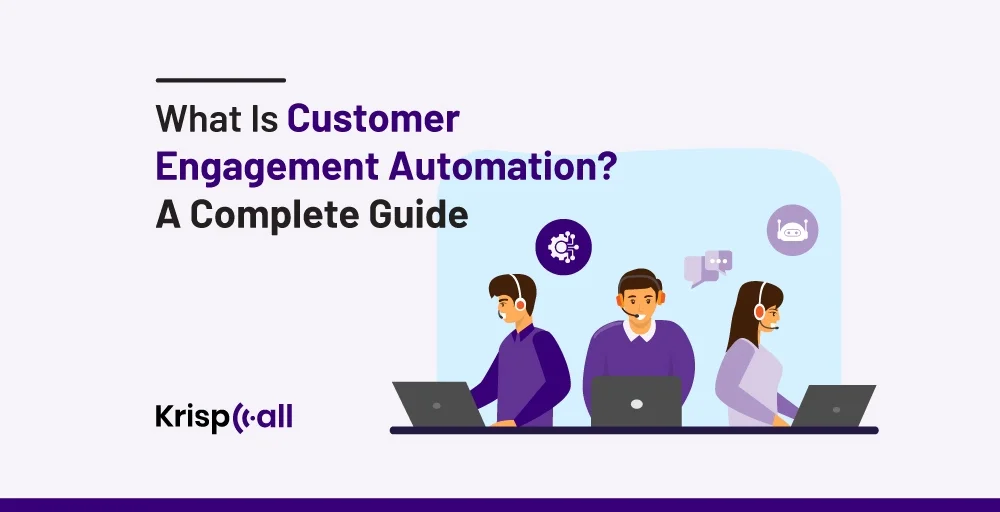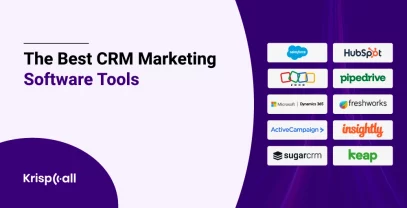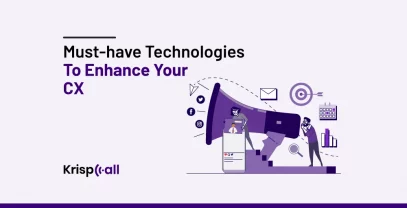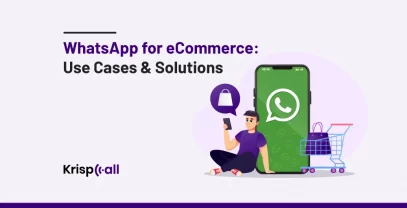Do you ever feel like you’re playing customer service whack-a-mole? Just as you answer one question, another pops up! 😴
Wouldn’t it be amazing to have a tireless helper who can answer FAQs, personalize interactions, and keep your customers happy around the clock? Well, this is where Customer Engagement Automation enters.
Customer Engagement Automation is a method that leverages the power of AI and other automation tools to help you enhance customer interactions.
In this comprehensive guide, we will explore customer engagement automation, its benefits, how it works, and why it’s a game-changer for businesses of all sizes. So, let’s start creating a customer experience that thrives on its own! 😀
🔑KEY HIGHLIGHTS
- Customer engagement automation leverages technology to automate customer interactions, enhancing customer engagement, satisfaction, and loyalty.
- Some key benefits of customer engagement automation are enhanced personalization, improved efficiency, better customer experiences, scalability, and competitive edge.
- Identifying customers, selecting an automated customer engagement platform, designing, executing, validating workflows, monitoring, and adjusting based on data are some ways to automate customer engagement.
- The best practices for customer engagement automation include mapping out the customer journey, utilizing different types of segmentation, and conducting A/B Testing.
What is Customer Engagement Automation?
Customer engagement automation (CEA) is a strategic approach that uses Artificial Intelligence (AI) and automation techniques to enhance customer interactions and relationships through personalized experiences, quick responses, and consistent engagement throughout the customer journey.
Customer engagement automation strategically combines various technologies to enhance business-to-consumer relationships, managing interactions from product introduction to post-purchase support to maximize customer value and foster lasting connections with the company.
This method streamlines repetitive tasks and processes by utilizing automated tools like chatbots, routing rules, and suggested articles, enabling businesses to provide timely, personalized assistance more effectively. This approach plays a crucial role in building robust and enduring customer relationships.
Key Benefits of Customer Engagement Automation
Implementing customer engagement automation into your business can unlock your way toward building a proper customer relationship.
So, here are some of the key benefits of customer engagement automation:
1. Enhanced personalization
Customer Engagement automation makes it easy for businesses to access customers’ data. Businesses can use these data to create personalized customer experiences that align with their preferences, behavior, and previous interactions. For example, you can capture your customers’ browsing or purchasing preferences and send them specific product recommendations they are likely to be interested in.
2. Improved efficiency
Automating customer engagement processes is one of the best ways to enhance operational efficiency by simplifying daily tasks. This makes it easy for businesses to concentrate on areas requiring enhancement while simultaneously reducing costs by eliminating unnecessary labor.
3. Better customer experiences
Customer engagement automation offers 24/7 support and answering customer questions. Being there for your customers all the time can drastically improve your customer’s experience. This plays a vital role in offering better customer satisfaction and building brand loyalty.
4. Competitive edge
Automating customer engagement provides valuable insights into customer behavior through the recording and analysis of data using customer feedback. This enables businesses to discover patterns and trends to help with product development and marketing strategies. It also helps businesses stay ahead of competitors and gain a deeper understanding of customer preferences.
5. Scalability
Scaling customer engagement efforts is one of the customer engagement automation’s forte. As your business expands, delivering personalized engagement to every customer can become burdensome. However, automated tools can assist you in scaling your engagements without compromising quality.
Automation also empowers businesses to engage with their customers on a larger scale, simplifying the management of numerous customer relationships. Customer engagement automation tools can also be tailored to suit your specific requirements.
6. Consistency
Consistency is necessary to build trust and enhance your brand’s overall reputation. By automating your customer engagement efforts, you can easily offer consistent and standardized customer interactions, which is a major plus point for your business to develop a sense of trust.
7. Accurate Targeting
Automated engagement tools can help businesses to analyze data, highlighting different aspects of customers. Using such data, you can segment and target customers based on behavior, demographics, and other factors. This can help you pitch the right offer and product to any customers, which increases sales and improves return on investments (ROI).
8. Proper data management
Automated customer engagement tools can assist businesses in efficiently gathering and organizing customer data. This valuable information can subsequently be utilized to enhance marketing and sales strategies, refine product development, and improve customer service.
9. Enhanced brand image
Automated customer engagement has the potential to significantly enhance your brand’s image. You can elevate your reputation and distinguish yourself from your competitors through tailored interactions.
10. Enhanced compliance strategies
Automated systems streamline the compliance process, reducing the likelihood of penalties and legal issues. By minimizing human errors, monitoring interactions for audit trails, and facilitating quick responses to compliance matters, these systems enhance data precision, maintain document authenticity, and ensure consistency with regulatory standards, thereby reducing the potential for penalties due to noncompliance.
11. Increased sales and revenue
Businesses can enhance their sales and revenue by delivering an exceptional customer experience, customizing interactions, and ensuring round-the-clock availability. Moreover, the valuable insights obtained from Customer Experience Analytics can assist businesses in recognizing opportunities for up-selling and cross-selling.
Customer Engagement Automation Examples
Here are some customer engagement automation examples:
1. Engaging User Onboarding
Initiating your customer success plan at the starting phase of the client’s journey is essential. So, you should always enhance your chances of success early on by utilizing a customer engagement automation platform during the initial stages. Customers will more likely recognize the benefits of your offering sooner if they are well-informed about how to utilize it.
If a customer does not understand your service fully, particularly in the first few days of starting, then the probability of renewal, referrals, and upgrades is bound to reduce.
By providing product tours, you can develop interactive tutorials that assist customers in setting up their accounts, customize their experience with videos, and showcase your key features effectively.
2. Initiated Upsells and Cross-Sells
Upselling and cross-selling triggered by customer behavior or preferences is an effective strategy for automating customer engagement. This approach involves offering complementary or upgraded products or services based on the customer’s previous purchases and preferences.
For example, if a customer has recently bought a new mobile phone, the system can automatically trigger a suggestion of a memory card or a mobile case. This not only benefits the customer but also increases the chances of additional purchases, thereby boosting the business’s revenue.
These upsells and cross-sells can be delivered through various channels such as email, mobile apps, or on-site pop-ups and can be customized for each individual customer.
By providing personalized recommendations and a seamless shopping experience, businesses can cultivate stronger relationships with their customers, resulting in enhanced loyalty and brand advocacy.
3. Self-Service Support Within The Product
The self-service support integrated into the product is the best example of customer engagement automation. This functionality empowers users to find solutions to their inquiries without the need to reach out to customer support or leave your platform.
For example, if you operate an online store specializing in beauty products, customers might be unsure about the product that suits their skin tone. In such scenarios, promptly offering a guide on how to look out for the perfect fit could aid the customer in finalizing their purchase, reducing any potential obstacles in their online shopping journey.
Businesses can also cut costs on customer support by enabling users to troubleshoot issues independently. Frequently Asked Questions (FAQ) sections, knowledge bases, and instructional videos are all valuable resources for self-service support.
How to Automate Customer Engagement?
After being familiar with the benefits customer engagement automation has to offer, wanting to implement it immediately is the right thing to do.
Here are some ways you can utilize to successfully automate customer engagement:
1. Identify Your Customer
Understanding the type of customer you are dealing with is the first thing to be wary of in order to develop a marketing automation platform effectively. This involves gaining a deep understanding of your customer base, including their interests, behaviors, and pain points.
Analyzing customer data helps you to identify opportunities where automation can provide benefits, such as in customer support. Additionally, it is important to align these findings with your business objectives and goals to ensure that the automated platform aligns with your overall strategy.
2. Select an Automated Customer Engagement Platform
It is important to select an automated consumer engagement tool that aligns with your business requirements and financial resources while also providing essential features.
- Omnichannel Support: When choosing an automated customer engagement platform, it is critical to consider different communication channels, such as email, social media, SMS, and mobile apps.
- User-friendly: The software should possess a user-friendly interface that is easy to navigate and demands minimal training for your staff to operate it efficiently.
- Personalization Capabilities: Platforms offering advanced resources for personalization depending on customer behavior, demographics, and preferences are the best for automated custom engagements.
- Integration and Compatibility: It is essential for new tools to seamlessly integrate with your current technology stack in order to enhance overall functionality.
- Analyzing: It is crucial to have real-time monitoring of essential data such as campaign performance, customer responses, and conversions.
- Scalability: A robust system should possess the capability to manage increasing customer bases and elevated communication volumes without encountering significant challenges.
3. Design, Execute, and Validate Your Workflows
Once you have selected an automated customer engagement platform, the next step you should focus on is to establish proper workflows. Workflows consist of different predetermined automatic responses triggered by customer actions.
For example, if a customer leaves items in their online shopping cart, you can design a workflow to automatically send them a reminder email.
So, implementing workflows requires setting up the following:
- Triggers: The events that start a workflow.
- Conditions: Rules that determine whether a workflow should be started or not.
- Actions: Automated tasks that are part of a workflow.
It is crucial to validate in order to ensure the proper functioning of all components. Mistakes offer valuable insights for enhancements.
4. Monitor and Adjust Based On Data
At last, it is crucial to continuously monitor and adjust your automated consumer engagement platform. By tracking data, identifying patterns, making necessary modifications, and optimizing marketing strategies, you can enhance the overall customer experience.
Best Practices for Automated Customer Engagement Strategy
Here is a breakdown of the best practices to follow to automate customer engagement strategy:
1. Map out the customer journey
Mapping out the customer journey plays a crucial role in helping you to understand the customer’s time with your business. From the first contact to the final conversion, analyzing the customer journey has got you covered.
So, to complete this first step, you should always remember to do the following things:
- Determine the communication channels through which your customers engage with your business
- Create a list of all potential engagements that customers may encounter during each phase.
- Categorize interactions based on their types.
- Clearly outline your objectives for using customer engagement automation at every interaction point.
These steps will help you select a suitable automated customer engagement platform that is in line with your goals, along with the appropriate triggers based on customers’ actions.
2. Utilize different types of segmentation.
Diving your customers based on different factors such as behavior, demographics, or preferences can provide you with a better vision about how to approach and what type of messages to send. This is effective in building proper connections with customers as well as increasing sales.
For example, suppose you operate an online store that specializes in selling a range of sports gear, and you aim to boost your customer interaction levels. Utilizing segmentation can greatly improve interaction while also increasing sales.
Here is a type of segmentation you can follow:
- Behavioral segmentation: In this segmentation process, you divide your customers based on their interaction with brands. Let’s take two groups. Group A is filled with customers who browse different products frequently but never make a purchase. On the other hand, Group B is filled with customers who regularly make purchases.
- Demographic segmentation: In this segmentation, customers are divided according to various criteria, including age, gender, geographical location, and income level. For instance, Group C could represent a demographic of youthful individuals who are keen on fashionable sports gear, whereas Group D comprises middle-aged women who prefer simple sports gear.
- Preference-based segmentation: This customer segmentation approach classifies customers according to their preferences. For instance, certain customers may prefer football products, whereas others may prefer exclusive offers and discounts.
After gathering a sufficient amount of data, you will be able to automate customized email reminders and product suggestions, along with seasonal deals and exclusive promotions.
3. A/B Testing
A/B testing basically involves testing two different versions of a message or workflow to determine which one offers better results. This method offers you a chance to figure out what is the right move for your business and focus your efforts on the winning strategy.
Conclusion
Customer engagement automation isn’t just about replacing human connection; it’s about creating a powerful partnership. By leveraging technology to streamline repetitive tasks and personalize interactions, you can free up your team to focus on what they do best: building relationships and providing exceptional customer service.
Remember, the key to success lies in a strategic approach. By understanding your audience, setting clear goals, and using the right tools, you can craft an automation strategy that keeps your customers engaged, happy, and returning for more.
So, unleash the power of automation, watch your customer satisfaction soar, and focus on what truly matters: building a loyal following that fuels your business growth.





